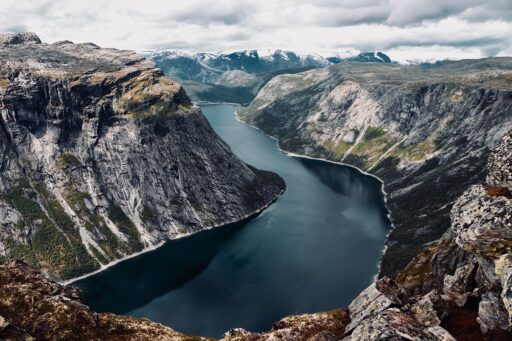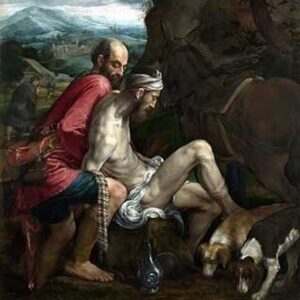Today, in honor of the new Nobel laureate, I’d like to look at the first of Jon Fosse’s works of fiction that I read, back in 2016, Aliss at the Fire. The most salient features of Fosse’s writing are present in this short novel from 2004. When I read Aliss at the Fire, Fosse’s monumental, mystical, prayerful Septology had not yet been published, but I knew Fosse had converted to Catholicism. I wanted to see if I could catch a glimpse of what led to that conversion by reading the earlier work. What I found was fiction that I would call fantasy, and fantasy is one of my basic criteria for religious sensibility. Another criterion is true love, and Fosse is a poet of true love.
Here is what I mean by true love, as expressed through the thoughts of the character Signe:
and they looked at each other, smiled at each other, and it was as though they were old friends, as though they had always known each other, in a way, just that it had been such an immeasurably long time since they had last seen each other, and that’s why they were so happy, to see each other again made them both so happy that happiness took over and steered them, it steered them to each other, as though this was something that was gone, that had been missing their whole lives, but now it was here, at last, it was here now, that’s how it felt then, that first time they met… it wasn’t frightening, no, it was like it was obvious, like there was nothing to do about it, it was certain, somehow, and whether she said or did one thing or another it was kind of like it didn’t make any difference, it happened the way it was meant to happen, it had all been decided in advance, she thinks, yes, yes that’s how it was
And here is what I mean by fantasy, again as expressed through Signe’s thoughts:
but she can’t stay standing in front of the window like this, she thinks, why does she do that all the time? and now she mustn’t think what she has thought so many times before, that she might just as well do that as do anything else, she thinks, instead she stays standing and she looks at a place in the middle of the fjord and then she loses herself in looking out at that place and she sees, lying there on the bench, herself standing there in front of the window and he too, she thinks, he too stood there so many times, just like she now sees herself standing there
The entirety of Aliss at the Fire occurs in the mind of a middle-aged woman named Signe who is lying on a bench in her house in rural Norway. That perspective is the outermost in a sort of Russian doll set of nested perspectives or visions. In fact, there is one perspective outside even that: the narrator, who begins by seeing Signe lying on the bench, then disappears for the rest of the book until the very end, when he hears her praying. Apart from the narrator, the scheme of the book works this way:
Signe sees her younger self on the day when her husband, Asle, went missing in the fjord. She watches herself do what she did that day, all the while being aware of herself in the present lying on the bench. This visionary recollection brings us back twenty-three years before 1979, when Asle was alive, and so we enter into Asle’s stream-of-consciousness as well. Both Asle and Signe, in the past time of the story, have visions of circumstances surrounding a tragic event further in the past that happened on the fjord by the house where Signe now lives alone, namely the death by drowning of Asle’s great-uncle, after whom Asle was named, on his seventh birthday.
Asle sees further still into the past—remember, we only see Asle through Signe’s retrospective vision—when he beholds his great-great-grandmother Aliss cooking sheep’s heads in a bonfire while tending to her son, Kristoffer, who will become the father of the Asle who dies on his seventh birthday, the great-uncle of our story’s Asle, who disappears in the fjord on November 17, 1979. Thus we have a story that, through hallucinatory recollection, spans from the early twenty-first century back to the late nineteenth century.
Fosse’s chosen style in almost all his fiction is stream-of-consciousness, which means there is no narrator, no telling of a story, but rather the direct representation of consciousness. Such fiction is immersive, and the tendency after you get used to it is to go with the flow of primordial images and feelings, many of which are not there but are memories and visions of the past. But within those memories what we find is mostly keen sensitivity to the environment. It is a contemplative fiction powerfully evocative of scene and landscape:
then she looks at the fjord lying there, always the same, always changing, and then she looks at the mountain on the other side of the fiord, so steep, plunging straight down somewhere between black and gray from the sky’s light movements that are somewhere between gray and white, down to the line of trees edging the fiord, and now the trees are black too, and it would be so nice if they were green again, shining green, she thinks and she looks at the mountain again, and, she thinks, it is as if the mountain down there was breathing out, no she really has to stop it now, thinking something like that, the mountain breathing out, that doesn’t make any sense, a mountain exhaling, she thinks, but still it is sort of like that, like the mountain was exhaling out there as it fell further and further down to the place where the trees start and then foothills and meadows, and houses
The world, in Fosse’s fiction, is articulate and erotic beyond language, apophatic and apocalyptic in the sense of revelatory of the supra-rational:
the old walls there settle into place all around him and say something to him, the same way they always have, he thinks, it’s always like that, whether he notices it and thinks about it or not the walls are there, and it is as if silent voices are speaking from them, as if a big tongue is there in the walls and this tongue is saying something that can never be said with words, he knows it, he thinks… Something that can’t be said but that is, just is, he thinks, and it’s almost like he is touching a person, he thinks, almost like something is being said the way something is said when you touch someone
It is not ultimately the intricate psychology of Fosse’s fiction that sticks with me, his characters so haunted by the past that they behold visions of themselves or their progenitors at moments of decision or tragedy or joy. What sticks with me are the images. Already in Aliss at the Fire Fosse shows the fascination with luminous darkness, a kind of nonduality or coincidence of opposites, that would become a central motif in Septology, and which seems to hint at the biblical image of the light that shines in the dark:
and he looks at the window and he looks at the flames reflected in the window and mixing with the darkness there outside and with the rain that’s now running down over the window, and then he hears the wind
even though the darkness is dense and thick around him in a weird way it’s not dark, he thinks, because the fjord is shining black
it is as if it’s totally dark and totally light at the same time, she thinks
These images and many others that recur in Fosse’s fiction—usually images of landscape and weather and of basic, crafted things like food, fiddles, boats—compose a kind of fantasy in the root sense of that which shows forth, something tangible, promising and beguiling which one can contemplate and behold as both its earthly self and otherworldly.
Jonathan Geltner lives in Ann Arbor MI with his wife and two sons. His translation of Paul Claudel’s Five Great Odes is available from Angelico Press and a novel, Absolute Music, is available from Slant. If you enjoy his posts at Close Reading, check out his new Substack, Romance and Apocalypse, for more frequent and in-depth essays on the places where literature and other arts meet religious ideas and experience.





